.png.webp)
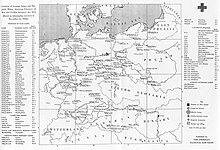
Nazi Germany operated around 1,000 prisoner-of-war camps (German: Kriegsgefangenenlager) during World War II (1939-1945).[1]
Germany had signed the Third Geneva Convention of 1929, which established provisions relating to the treatment of prisoners of war.
- Article 10 required that PoWs should be lodged in adequately heated and lighted buildings where conditions were the same as for German troops.
- Articles 27-32 detailed the conditions of labour. Enlisted ranks were required to perform whatever labour they were asked if able to do, so long as it was not dangerous and did not support the German war-effort. Senior Non-commissioned officers (sergeants and above) were required to work only in a supervisory role. Commissioned officers were not required to work, although they could volunteer. The work performed was largely agricultural or industrial, ranging from coal- or potash-mining, stone quarrying, or work in saw mills, breweries, factories, railroad yards, and forests. PoWs hired out to military and civilian contractors were supposed to receive pay. The workers were also supposed to get at least one day a week of rest.
- Article 76 ensured that PoWs who died in captivity were honourably buried in marked graves.
In general, Nazi Germany often disobeyed these rules, resulting in the deaths of millions of prisoners. [2]
Types of Camps
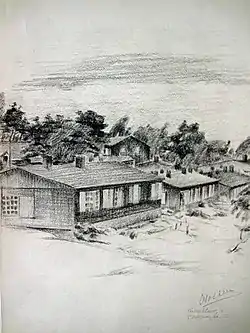
- Dulag or Durchgangslager (transit camp) – These camps served as a collection point for POWs prior to reassignment. These camps were intelligence collection centers.
- Dulag Luft or Durchgangslager der Luftwaffe (transit camp of the Luftwaffe) – These were transit camps for Air Force POWs. The main Dulag Luft camp at Frankfurt was the principal collecting point for intelligence derived from Allied POW interrogation
- Heilag or Heimkehrerlager (repatriation camps) - Camps for the return of prisoners. Quite often these men had suffered disabling injuries.
- Ilag/Jlag or Internierungslager ("Internment camp") – These were civilian internment camps.
- Marlag or Marine-Lager ("Marine camp") – These were Navy personnel POW camps.
- Milag or Marine-Internierten-Lager ("Marine internment camp") – These were merchant seamen internment camps.
- Oflag or Offizier-Lager ("Officer camp") – These were POW camps for officers.
- Stalag or Stammlager ("Base camp") – These were enlisted personnel POW camps.
- Stalag Luft or Luftwaffe-Stammlager ("Luftwaffe base camp") – These were POW camps administered by the German Air Force for Allied aircrews.
Nomenclature
At the start of World War II, the German Army was divided into 17 military districts (Wehrkreis), which were each assigned Roman numerals. The camps were numbered according to the military district. A letter behind the Roman number marked individual Stalags in a military district.
e.g.
- Stalag II-D was the fourth Stalag in Military District II (Wehrkreis II).
Sub-camps had a suffix "/Z" (for Zweiglager - sub-camp). The main camp had a suffix of "/H" (for Hauptlager - main camp).
e.g.
- Oflag VII-C/H meant this is the main camp.
- Oflag VII-C/Z meant this is a sub-camp of a main camp.
Some of these sub-camps were not the traditional POW camps with barbed wire fences and guard towers, but merely accommodation centers.
List of Camps by Military District
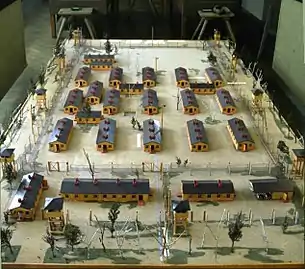
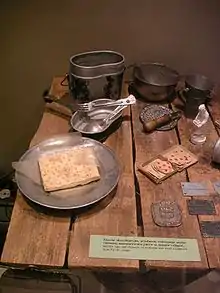
Military District I (Königsberg)
- Stalag I-A Stablack, Preußisch Eylau
- Stalag I-B Hohenstein
- Stalag I-C, from June 1943: Stalag Luft VI, Heydekrug
- Stalag I-D Montwy
- Stalag I-E Prostken
- Stalag I-F Sudauen
Military District II (Stettin)
- Stalag II-A Neubrandenburg
- Stalag II-B Hammerstein–Schlochau
- Stalag II-C Greifswald
- Stalag II-D Stargard
- Stalag II-E Schwerin
- Stalag II H Raderitz
- Oflag II-A Prenzlau
- Oflag II-B Arnswalde
- Oflag II-C Woldenberg
- Oflag II-D Gross Born
- Oflag II-E Neubrandenburg
Military District III (Berlin)
- Stalag III-A Luckenwalde
- Stalag III-B Fürstenberg/Oder
- Stalag III-C Alt-Drewitz
- Stalag III-D Berlin
- Oflag III-A Luckenwalde
- Oflag III-B Wehrmachtlager Tibor/Zuellichau
- Oflag III-C Lübben/Spree
Military District IV (Dresden)
- Stalag IV-A Elsterhorst
- Stalag IV-B Mühlberg (Elbe)
- Stalag IV-C Wistritz bei Teplitz
- Stalag IV-D Torgau
- Stalag IV-E Altenburg
- Stalag IV-F Hartmannsdorf
- Stalag IV-G Oschatz
- Oflag IV-A Hohnstein
- Oflag IV-B Koenigstein
- Oflag IV-C Colditz Castle
- Oflag IV-D Elsterhorst
Military District V (Stuttgart)
- Stalag V-A Ludwigsburg
- Stalag V-B Villingen
- Stalag V-C Wildberg
- Stalag V-D Strasbourg
- Oflag V-A Weinsberg
- Oflag V-B Biberach
- Oflag V-C Wurzach
Military District VI (Münster)
- Stalag VI-A Hemer/Iserlohn
- Stalag VI-B Neu-Versen
- Stalag VI-C Oberlangen/Emsland
- Stalag VI-D Dortmund
- Stalag VI-F Bocholt
- Stalag VI-G Bonn–Duisdorf
- Stalag VI-H Arnoldsweiler/Dueren
- Stalag VI-J S.A. Lager Fichtenhein/Krefeld and Dorsten
- Stalag VI-K Stukenbrock
- Oflag VI-A Soest
- Oflag VI-B Doessel–Warburg
- Oflag VI-C Eversheide/Osnabrück
- Oflag VI-D Münster
- Oflag VI-E Dorsten
Military District VII (Munich)
- Stalag VII-A Moosburg
- Stalag VII-B Memmingen
- Oflag VII Laufen
- Oflag VII-A Murnau am Staffelsee
- Oflag VII-B Eichstaett
- Oflag VII-C Laufen
- Oflag VII-D Tittmoning
Military District VIII (Breslau)
- Stalag VIII-A Görlitz
- Stalag VIII-B Lamsdorf
- Stalag VIII-C Sagan
- Stalag VIII-D Teschen
- Stalag VIII-E/308 Neuhammer
- Stalag VIII-F Lamsdorf
- Oflag VIII-A Kreuzburg/Oppeln
- Oflag VIII-B Silberberg
- Oflag VIII-C Juliusburg
- Oflag VIII-D/Tittmoning Castle
- Oflag VIII-E Johannisbrunn
- Oflag VIII-F Mährisch-Trübau
- Oflag VIII-G Weidenau/Freiwaldau
- Oflag VIII-H/H Oberlangendorf/Sternberg
- Oflag VIII-H/Z Eulenberg/Roemerstadt
Military District IX (Kassel)
- Stalag IX-A Ziegenhain
- Stalag IX-B Wegscheide/Bad Orb
- Stalag IX-C Bad Sulza
- Oflag IX-A/H Burg Spangenberg
- Oflag IX-A/Z Rotenburg/Fulda
- Oflag IX-B Weilburg/Lahn
- Oflag IX-C Molsdorf near Erfurt
Military District X (Hamburger)
- Stalag X-A Schleswig
- Stalag X-B Sandbostel
- Stalag X-C Nienburg/Weser
- Oflag X Hohensalza
- Oflag X-A Itzehoe
- Oflag X-B Nienburg/Weser
- Oflag X-C Lübeck
- Oflag X-D Fischbek
Military District XI (Hanover)
- Stalag XI-A Altengrabow
- Stalag XI-B Fallingbostel
- Stalag XI-C Bergen-Belsen
- Stalag XI-D Oerbke
- Oflag XI-A Osterode am Harz
Military District XII (Wiesbaden)
- Stalag XII-A Limburg an der Lahn
- Stalag XII-B Frankenthal/Palatinate
- Stalag XII-C Wiebelsheim/Rhein
- Stalag XII-D Trier/Petrisberg (Trèves)
- Stalag XII-E Metz
- Stalag XII-F Forbach
- Oflag XII-A Hadamar/Limburg an der Lahn
- Oflag XII-B Mainz
Military District XIII (Nuremberg)
- Stalag XIII-A Sulzbach-Rosenberg, Oberpfalz
- Stalag XIII-B Weiden/Oberpfalz
- Stalag XIII-C Hammelburg/Mainfranken
- Stalag XIII-D Nuremberg-Langwasser
- Oflag XIII-A Nuremberg-Langwasser
- Oflag XIII-B Hammelburg
- Oflag XIII-D Nuremberg-Langwasser
Military District XVII (Vienna)
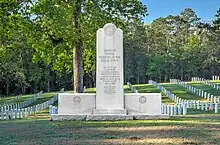
- Stalag XVII-A Kaisersteinbruch
- Stalag XVII-B Krems–Gneixendorf. Formerly named Dulag Gneixendorf
- Stalag XVII-C Döllersheim. Previously named Dulag Döllersheim
- Stalag XVII-D Pupping. Previously named Zweiglager Pupping, renamed Stalag 237, Stalag 397, and finally Stalag 398 Pupping
- Oflag XVII-A Edelbach
Military District XVIII (Salzburg)
- Stalag XVIII-A Wolfsberg
- Stalag XVIII-A/Z Spittal
- Stalag XVIII-B Oberdrauburg
- Stalag XVIII-C Markt Pongau
- Stalag XVIII-D Maribor
- Oflag XVIII-A Lienz/Drau
- Oflag XVIII-B Wolfsberg/Kaernten
- Oflag XVIII-C Spittal/Drau
Military District XX (Danzig)
- Stalag XX-A Thorn (Poland)
- Stalag 312 (also known as Stalag XX-C) Thorn (Poland) Same as above
- Stalag XX-B Marienburg (Poland)
Military District XXI (Posen)
- Stalag XXI-A Schildberg (Poland)
- Stalag XXI-B Schubin (Poland)
- Stalag XXI-B Thure (Poland)
- Stalag XXI-C/H Wollstein (Poland)
- Stalag XXI-C/Z Graetz
- Stalag XXI-D Posen (Poland)
- Oflag XXI-A Schokken (Poland)
- Oflag XXI-B Schoken (Poland)
- Oflag XXI-C Schubin/Schokken/Schildberg (Poland)
- Oflag XXI-C/Z Grune bei Lissa (Poland)
Other Camps
- Oflag 6 Tost (Poland)
- Oflag 53 Pagėgiai (Lithuania)
- Oflag 60 Širvintos (Lithuania)
- Oflag 64 Schubin
- Oflag 79 Waggum, Braunschweig
- Stalag 56 Prostken (Poland)
- Stalag 133 Rennes (France)
- Stalag 302 Gross-Born
- Stalag 307 Biała Podlaska (Poland)
- Stalag 307 Dęblin (Poland)
- Stalag 313 Czarne (Poland)
- Stalag 315 Przemyśl (Poland)
- Stalag 319 Chełm (Poland)
- Stalag 323 Gross-Born
- Stalag 324 Grodno (Belarus)
- Stalag 325 Zamość (Poland)
- Stalag 325 Rawa Ruska (Poland)
- Stalag 327 Jarosław (Poland)
- Stalag 328 Lemberg (Poland)
- Stalag 329 Winniza (Ukraine)
- Stalag 333 Ostrów-Komorowo (Poland)
- Stalag 336 Kaunas (Lithuania)
- Stalag 339 Kyiv-Darniza (Ukraine)
- Stalag 342 Maladetschna (Belarus)
- Stalag 343 Alytus (Lithuania)
- Stalag 344 Vilnius (Lithuania)
- Stalag 351 Berkenbrugge
- Stalag 355 Khmelnytskyi Ukraine
- Stalag 357 Kopernikus (Poland)
- Stalag 359 Poniatowa (Poland)
- Stalag 361 Šiauliai (Lithuania)
- Stalag 366 Siedlce (Poland)
- Stalag 367 Częstochowa (Poland)
- Stalag 369 Krakau (Poland)
- Stalag 369 Kobierzyn (Poland)
- Stalag 371 Stanislau (Poland)
- Stalag XX-A (301) Friesack, Wutzetz/Brandenburg, (Germany)
Luftwaffe Camps
The camps for Allied airmen were run by the Luftwaffe independently of the Army.
- Dulag Luft Oberursel, Frankfurt
- Stalag Luft I Barth
- Stalag Luft II Litzmannstadt (Poland)
- Stalag Luft III Sagan
- Stalag Luft IV Groß Tychow (Poland)
- Stalag Luft V Halle/Saale
- Stalag Luft VI Heydekrug
- Stalag Luft VII Bankau
- Stalag Luft VIII-B Lamsdorf
- Stalag Luft XI-B
Kriegsmarine Camps
The camp for Allied seamen was run by the Kriegsmarine independently of the Army.
References
- ↑ Eric Lichtblau (3 March 2013). "The Holocaust Just Got More Shocking". New York Times. Archived from the original on 11 April 2013. Retrieved 5 March 2013.
- ↑ {{cite Goldhagen, Daniel. Hitler's Willing Executioners. p. 290. 2.8 million young, healthy Soviet POWs" killed by the Germans, "mainly by starvation ... in less than eight months" of 1941–42, before "the decimation of Soviet POWs ... was stopped" and the Germans "began to use them as laborers.}}
External links
- Map of German World War II Prisoner of War Camps
- Lamsdorf Remembered
- POW Camp Listings
- Stoker Harold Siddall Royal Navy, captured on Crete and his life in Stalag VIIA
- The Memorial of Esterwegen - The Emsland Camps
- Oflag VC Wurzach / Ilag (Civil internees from Jersey)
- Stalag VIIIC and Stalag Luft 3 POW Camps Museum in Zagan, Poland
- Official list of World War II Stalags (in German)
- Official list of World War II Oflags (in German)
- List of Nazi camps for Allied POWs in Germany and occupied territories (in German)
Post VE Day sending of German PoWs to Alaska, to dismantle war equipment http://www.sitnews.us/Kiffer/POWCamp/021715_prisoners_of_war.html